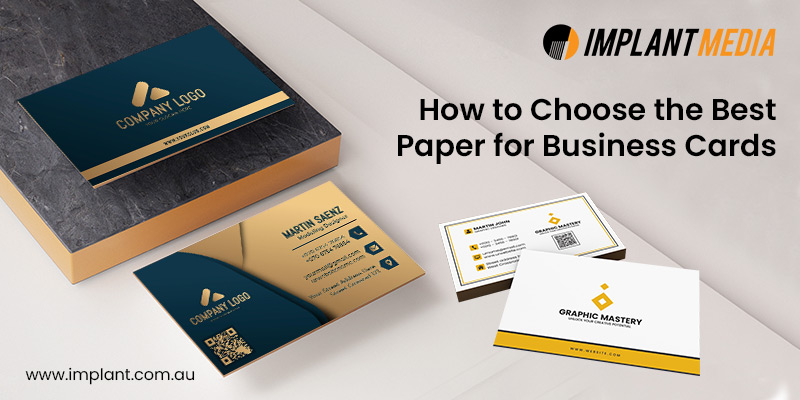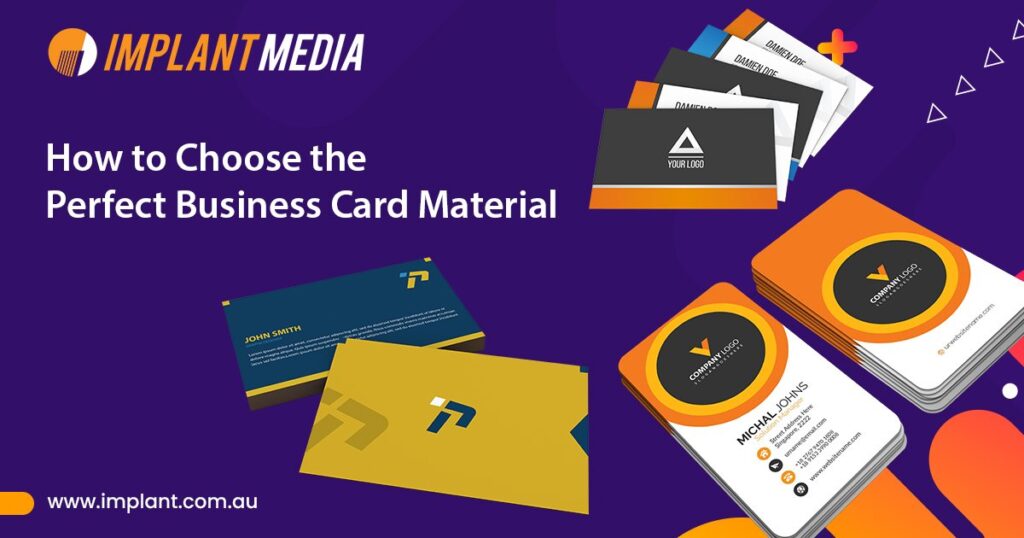Have you considered the material to print your business card and can’t seem to decide, or are you looking for the best paper for Business Cards? Your business card is the first thing other people get to see and perhaps the last thing they associate with you, hence the need for the right material. However, from recycled paper to quality business card stock, with all the available choices, how does one distinguish between them and tell which one is the best? This blog will assist you in finding your way in the selection of business card materials and choosing the one that corresponds to your company’s image, along with high-quality business card printing in Australia.
Why Your Business Card Material Matters
The material of your business card isn’t just about aesthetics; it reflects the quality of your brand. Just as a cheap paper can state that the owner didn’t pay much attention to details, a thick, expensive card will reflect professionalism and care. Here, we will look at the various types of material that can be used in your business card.
The Varying Materials Employed in Business Cards
Standard Cardstock: The Go-To Choice
Standard business card stock, a smooth-surfaced generic type of card, is the most popular material that is used in business card printing. Some of the merits include its being cost-effective, popular among most types of business across the country, flexible, efficient in undertaking its functions, and easily accessible and widely accepted. Generally ranging from 300–350 GSM, most of the card stocks promote satisfactory weight, both strength and flexibility.
Pros:
Affordable, readily available, and versatile as far as the printing of material is concerned.
Cons:
It can often be considered to feel somewhat less premium when compared to the other choices.
For basic and most dependable business card printing in Australia, the standard card stock proves to be efficient.
Premium Business Card Stock: Elevate Your Brand
If one wants to make a more conspicuous iteration, then using the premium cardstock is recommended. There is a cover fabric that has a higher GSM, approximately 400–450, and as such, this makes the material feel more premium. Cardstock comes with other finishes, such as a gloss matte or soft feel, which is felt when handling the final product.
Pros:
Appears to be more luxurious, and long-lasting, and, in most cases, it is accompanied by numerous finishing styles.
Cons:
A costlier form of the usual cardstock paper, while still widely available.
Selecting the best paper for business cards means being extremely rational and carefully estimating the value of the first impression against the money you are willing to spend. Quality thick paper is perfect for corporate entities that wish to portray the image of a company that has a lot of value to offer.
Recycled Business Card Stock: An Eco-Friendly Option
Recycling is the way to go in today’s world and what better way to make that statement than with cardstock that has been recycled? This business card stock is created from recycled materials and its target market is the green-conscious consumer.
Pros:
Non-toxic, sensitive to the touch, and promising to clients with some consciousness of the state of the environment.
Cons:
Might have a somewhat increased surface roughness and restricted permissible surface treatment.
Textured Business Card stock: Add a Unique Touch
Textured cardstock is also good for business cards if you seek to get a more profound touch of the material used in your cards. This is available in patterns such as linen, felt, or hammered finishes that make the card distinct in terms of looks and feel.
Pros:
It provides its unique touch, helps to make changes for design objectives, and becomes an unforgettable card.
Cons:
Costlier at the same time and can only be used for simple designs.
Plastic Cards: Modern and Durable
Due to their toughness and sleek look, plastic cards are equally becoming preferred by different firms. These can be clear or frosted, or come in any solid color; in general, they are less likely to succumb to wear and tear than traditional paper ones.
Pros:
Fireproof, waterproof, and have a certain style that makes them outstanding.
Cons:
Bigger comes with a higher price tag and is not as environmentally sensitive.
Metal Business Cards
Stainless Steel:
Stainless steel business cards are durable and luxurious, perfect to be used by industries such as banking and property.
Pros:
Anticipated durability and a luxurious touch to products that have this coating.
Cons:
Higher in cost and denser than the other types of products in the market.
Aluminum:
Aluminum cards are even lighter compared to the stainless steel yet very strong, they present the people with a very nice and functional type of card.
Pros:
Lightweight and affordable.
Cons:
less premium feel than the stainless steel.
How to Choose the Best Paper for Business Cards

When selecting the best paper for business cards, consider the following factors:
Your Brand Identity
Consider your brand’s values and how you want to be perceived. For example, if there is more trade and style, a luxurious company will decide to use premium card stock or metal, not normal card stock or metal. An environmentally friendly firm will choose to use recycled paper or any friendly paper.
Durability
If your business cards are frequently handled or exchanged, durability becomes a key factor. Of course, the concept of their utility appears to be the most appropriate. Paper is usually used for ordinary forms of these cards though plastic and metal forms of these cards can be used to make a card more durable.
Budget
The material on which your business cards are going to be printed differs, to some extent at least, with the sum of money you would like to spend on this. Among the basic options, some are much more expensive than even the average premiums but have much higher perceived value, such as the 14–16 pt card stock, which can produce very good quality prints at a relatively lower price.
Weight and Thickness
Choice business card material also shows weight by the thickness and density of the material used. In some ways, the denser a card is, everything just gets thicker and somehow more luxurious. Stock generally ranged from 300 to 600 GSM; the figure refers to the thickness of the paper employed in the card.
Finish
The last step of the coated business card material can change the feel of the material that the card is made of. Popular finishes include:
Glossy:
It is translucent and can retain its bright colors seemingly without fading.
Matte:
Standard and plain; the appearance is suitable for a modern and simple design of the software’s interface.
Uncoated:
Natural and sleek, suitable for writing anything on the card.
Quality Printing Techniques
The nature of a particular material means it is invariably important to know how it performs in relation to other kinds of printing techniques. For example, if using textured cardstocks, then complexity is not so advantageous to work, or when using plastic, then the number of tones will not be so vast.
Environmental Impact
Recycled paper is good for brands who are conscious of the ecology of their enterprise. Incidentally, it is convenient when you and your customers wish to provide as ‘green’ a business card as possible.
Bring the Snap-in Your Business Card with Implant Media
At Implant Media, we realize that the business card is far more than it appears to be — it’s a reflection of your brand. We have the best visiting card printing service in Australia , and here is a glimpse of the printing services that we provide- standard, premium, and all things in between. It is crucial to choose the best material for business cards, and our skilled specialists will be happy to offer you the choice that will meet your business needs and correspond to its image. Whether it be a matte or even recycled stock or something completely different, you are in safe hands with Implant Media, which provides you with the best premium quality business card material.
Stand Out to Show Your Worth in Business with the Right Business Cards
This is the very first and, maybe, the only glimpse of your company that a potential customer or a partner can get. When choosing the right business card material, what one is doing is making this first touch, a lasting one. Remember, don’t be ordinary; go for a card that illustrates the kind of business that you are undertaking. By use of card thickness, finish, and design, it is possible to have a business card that has the potential to market your business way beyond the standard identification tool.
Ready to make your business card distinctive? Find your ideal business card design and order with Implant Media today, fill out the form for a free quotation and let us design a business card for your company.


